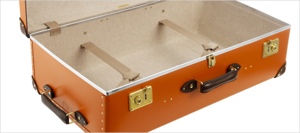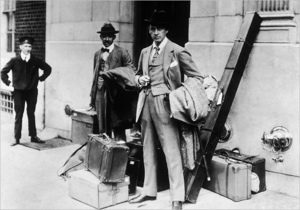
A unique combination of tradition, secret materials, and innovation
Globe-Trotter is a luxury brand that was founded by Englishman David Nelken in Saxony, Germany, in 1897. In 1901, the company returned to the UK, and it has been there ever since. The values that have always defined the style of this brand are not difficult to identify: heritage and craftsmanship. Typically British characteristics, you could say. However, what is truly unique about this House is its inimitable way of combining traditional techniques with a focus on new design, whether this regards colour, materials or design.

The wonderful period photographs that the company possesses provide a superb portrait of the brand, in the hands of figures such as Winston Churchill who used the 18-inch attaché case while he was Chancellor of the Exchequer, Queen Elizabeth II, who used Globe-Trotter cases for her honeymoon, Sir Edmund Hilary, who found the suitcases ideal to take his kit up to first base cap during his assault on Everest in 1951, and more recently, Daniel Craig, Kate Moss, Sofia Coppola and Kylie Minogue, to name just a few. Its powerful image has led it to being chosen by other luxury brands who use Globe-Trotter products in their visual communications. Examples include 10 Corso Como, Vogue, Wallpaper, Hermès, Liberty of London, Ross Lovegrove and Junya Watanabe.

The Globe-Trotter factory in Hertfordshire makes the cases by hand on Victorian machinery, in a unique material, “Vulcan Fibre” or vulcanised fibreboard. This was invented in the UK in the 1850s, and it is basically 14 layers of paper that are bonded together and coloured – though the exact process is a patented and closely-guarded secret. It has never been successfully imitated. Vulcan fibre is a very tough but light material, as lightweight as aluminium, but as hardwearing as finest leather. In fact, Globe-Trotter cases are extremely tough, and the company has an archive of suitcases that are up to 100 years old. The frame is in ash wood, while the lining is in fabric, and the trim is of course in leather. Cases are riveted, lined and trimmed by hand. Many of the craftsmen at the company have been working for Globe-Trotter for decades, and this highlights the great satisfaction that is derived from creating high-quality products.
The toughness of Vulcan fibre has featured strongly in the company’s communications over the decades. The image of an elephant standing on a case is not just advertising. A test was actually performed at the Zoological Gardens in Hamburg, with a 1 tonne elephant that stood on a Globe-Trotter case with its full weight. The case withstood the pressure. Still today, the factory sometimes receives 100-year old cases that are sent in to have their linings changed. Globe-Trotter luggage sets fulfil the need for lightweight suitcases in modern travel.
Globe-Trotter applies an original approach to colour. In the early days of travel, luggage was all brown and black. Even then, Globe-Trotter decided to make a splash with some new colours. Blue was one of the first additions to the range, expressing sea and air travel. More recently, the brand has introduced other colours, and original print designs. Today, the classic colours of navy, black, green, ivory and colonial brown, of timeless appeal, have been joined by more modern shades such as Jewel pink, Cruise blue, Centenary red and Orange/Tan. Globe-Trotter has not subscribed to the complex interior pockets that are a feature of many luggage brands, preferring absolute simplicity. This ensures that travellers have the maximum space possible.
Today, the company’s products include the ‘Original’ series, with the signature leather straps and a limited range of classic colours. This range has remained the same since 1897, from when the company was established. The ‘Centenary special edition’ was launched in 1997 to celebrate the 100th anniversary, and it features classic and pop colours, with high quality leather corners and straps. The ‘Safari’ series is based on cases made by Globe-Trotter in the late 1920s, and they comprise ivory-colour cases, resembling those used by explorers who travelled the world by cruise liner. The ‘Cruise’ series is striking in its royal blue colour, with navy blue straps and corner details. Inside, the lining of white cotton with pinstripe blue stripes is a superb expression of summer seaside living. The ‘Orient’ collection features a hand-lacquered gloss finish, created using valuable Urushi lacquer, with fine designer oriental silk linings.
‘Onehundred&ten’ was designed by Ross Lovegrove, and it is hand-made in Japan from 3X fibre, comprising woven carbon fibre and tri-axial woven Kevlar. These two materials are layered and bonded to create the first-ever next-generation Globe-Trotter hard case, weighing just 1.4 kg.
The Burlington Arcade flagship store (54-55 Burlington Arcade, Mayfair, London W1J 0LB, tel. +44 20 7529 5950) is an appropriately refined experience, with interiors influenced by 19th century British architect Sir John Soane. On the second floor, customers discover a totally different atmosphere with respect to the ground and first floor, and can relax amidst plush furniture and a range of images and artefacts from Globe-Trotter’s long and glittering history. Here, bespoke cases can be ordered, unique for colour, linings, leather corners, and personalized initials. Another bespoke feature available at the Burlington Arcade store are cases without wheels – in fact today’s Globe-Trotter cases are made with wheels as standard.
In London, products are also available at Harrods, Selfridges, Browns and The Conran Shop. Products are distributed worldwide by means of selected retailers, which can be seen at the store locator on the company website.
For further information on Globe-Trotter and its products, see www.globe-trotterltd.com
Published in April 2010, luxos.com